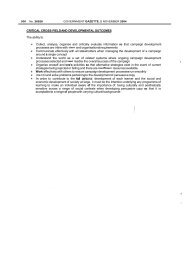Abductions,Disappearances and Missing Persons - South African ...
Abductions,Disappearances and Missing Persons - South African ...
Abductions,Disappearances and Missing Persons - South African ...
You also want an ePaper? Increase the reach of your titles
YUMPU automatically turns print PDFs into web optimized ePapers that Google loves.
t h e re can be no violation <strong>and</strong> there f o re no perpetrator. This is characteristic of<br />
the disappearances carried out by state agents in the <strong>South</strong> <strong>African</strong> situation.<br />
21. Another important characteristic of disappearances is that, once a state has<br />
chosen to embark on this road to criminality, policy decisions in this respect tend<br />
to be taken centrally – although the process of execution is usually decentralised.<br />
<strong>Disappearances</strong> are usually planned by small secret groups within the armed<br />
f o rces, where orders for implementation are delegated through various channels<br />
that are often difficult to trace. Depending on the nature of the particular situation,<br />
disappearances are usually carried out by military groups, paramilitary gro u p s ,<br />
the police or death squads operating within either police or military structure s .<br />
G o v e rnments usually permit these groups a great deal of latitude to carry out<br />
these deeds, <strong>and</strong> usually disavow all knowledge of the disappearances.<br />
22. S e c recy is another important facet of disappearances. In the <strong>South</strong> <strong>African</strong><br />
situation, a number of units within the police <strong>and</strong> military became secretly involved<br />
in disappearances <strong>and</strong> killings. These units enjoyed a large degree of autonomy<br />
<strong>and</strong> had access to the funds necessary to take people into custody, make them<br />
disappear <strong>and</strong> kill them. The existence of these units <strong>and</strong> the secre c y with which<br />
they operated made it possible for the former state to deny any involvement in such<br />
activities. In addition, once their activities became known, the political authorities<br />
of the former state continued to insist that they had no knowledge of the actions o f<br />
these structures, <strong>and</strong> that the latter had been acting without authorisation.<br />
23. H o w e v e r, the high rank of the state personnel involved, their easy access to<br />
funds <strong>and</strong> resources, <strong>and</strong> evidence emerging from amnesty applications by former<br />
security force personnel negate this argument. One cannot but draw the conclusion<br />
that the former state was centrally involved, not only in sanctioning this tactic,<br />
but also in planning <strong>and</strong> providing funds <strong>and</strong> re s o u rces.<br />
24. When governments are addressed on this issue – either by the international<br />
community or by human rights groups – they often reply that the person has<br />
fled the country <strong>and</strong> gone into exile. In a number of cases in <strong>South</strong> Africa, the<br />
former state sought to blame the liberation movements for a disappearance. When<br />
laying complaints or seeking answers from the police, families were fre q u e n t l y<br />
advised that the disappeared had probably gone into exile. The state encouraged<br />
families to believe this <strong>and</strong>, in some instances, staged elaborate hoaxes to hide<br />
the fact that it was responsible for the disappearance. The cases of Mr Stanza<br />
Bopape, Ms Portia Ndw<strong>and</strong>e <strong>and</strong> Mr Moss Morudu are just a few examples.<br />
V O L U M E 6 S E C T I O N 4 C H A P T E R 1 P A G E 5 1 6

















